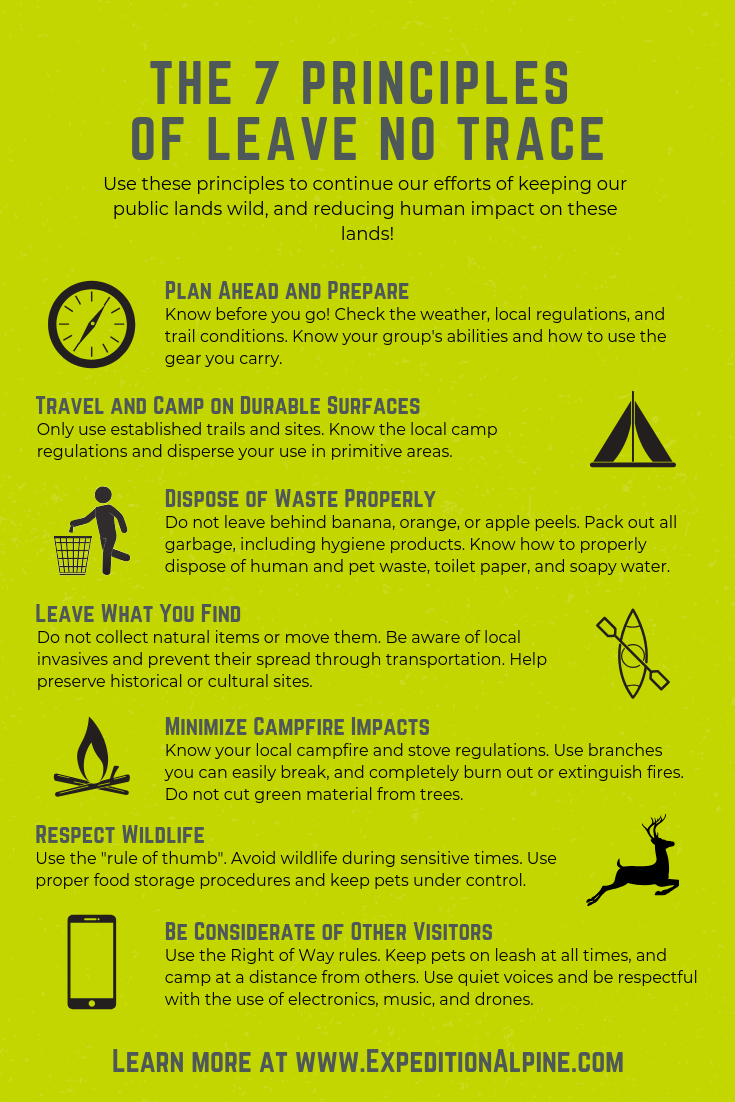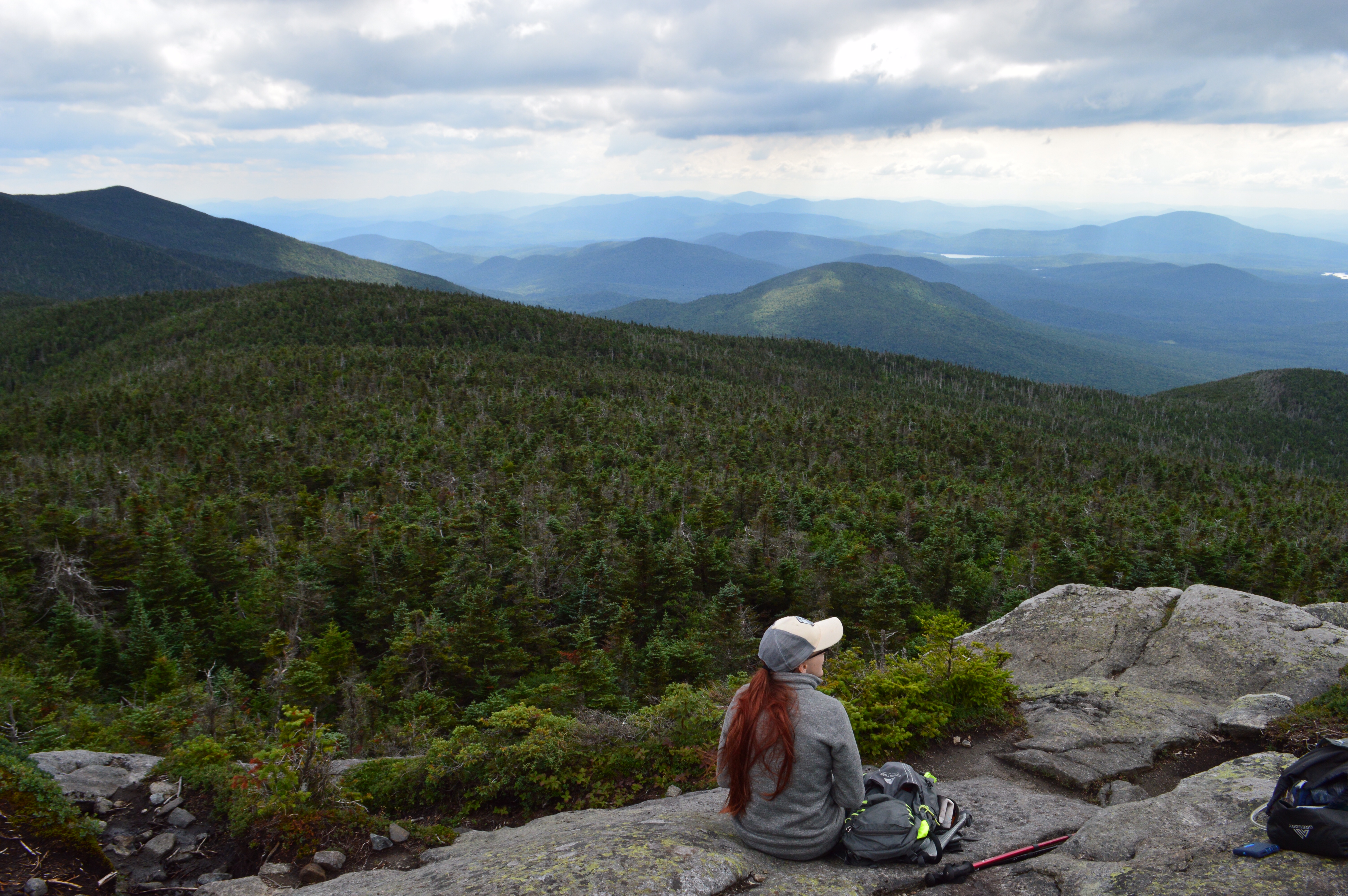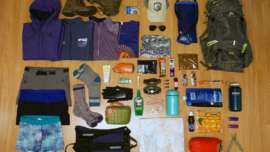Leave No Trace (LNT) is one of those topics that gets beaten to death on Facebook hiking pages and forums. But how many people know all of the principles? And why do they really matter?
The Leave No Trace Center for Outdoor Ethics estimates that there are over 13 billion recreational visits to the outdoors every year! This number is rapidly increasing as the population grows and cities encroach on our wild lands. Ultimately, the Leave No Trace principles are the fundamental basics to keep our backcountry wild for generations to come. Many of these principles also help ensure your wellbeing by keeping the environment clean.
The Principles of Leave No Trace

#1 – Plan Ahead and Prepare
This principle is focused on awareness. Awareness of the conditions (weather, trail, and traffic on the trails), awareness of yourself or your group, and awareness of your knowledge in the backcountry.
Awareness of Environmental Conditions
Pay attention to the regulations in the area you are visiting. Are fires allowed? Where can you camp (are there restrictions on camping at a certain elevation, or in other fragile areas)? What are the current trail conditions? These important questions help you think about your impact on the environment and how you can practice Leave No Trace.
Weather
What will the weather conditions be? If it’s rainy or very wet, you may want to avoid fragile wetland
Gear
In regard to the weather, you should pack the right gear for the conditions. Having the proper gear will help limit wear and tear on our trails, and allow you to leave no trace! An example of this would be carrying microspikes during the shoulder seasons (early spring/late fall) as opposed to bare-booting it. Without that gear, you would have to walk off trail around icy sections, widening the trail and possibly putting yourself in danger. Gaiters during mud season have a similar purpose. They keep the mud out of your boots and allow you to stay on-trail instead of trampling vegetation.
Trail Traffic
Be aware of the expected traffic on the trail. Some places may be less traveled, and others are frequently packed full of people. Weekends, holidays, local events, and the weather can play a large part in traffic levels. Try to pick a trail that won’t be extremely busy, so that you can limit the environmental impact and erosion in that area.
Awareness of Self
The last important part of this principle is to be aware of yourself and your group. If you choose to visit on a popular day, try to limit your group size. If you have a large group, split up into smaller groups that will hike separately and meet at a designated point. Be aware of the garbage you make. Repackaging food at home can help limit the amount of garbage you bring in. It can also reduce weight in your pack. Be aware of the skills of the people in your group. If your route is too challenging, people may try to cut corners and make shortcuts to bypass difficult sections. This will add to the wear and tear on our trails. Know how to use a map and compass to reduce wrong turns, and the need for marking or flagging trees.
#2 – Travel and Camp on Durable Surfaces
This principle is pretty self-explanatory. Durable surfaces are described as “established trails or campsites, and areas of rock, gravel, dry grasses, or snow”. You should always camp at least 200 feet from water sources to protect the fragile ecosystems that live around them.
In popular areas, it is recommended to only use existing trails and campsites, and to walk single file. This reduces further wear and tear to our wild lands. However, in more pristine/primitive areas, you should disperse use. Spread out where you travel and camp to reduce the likelihood of killing off the local flora and creating trails or other human impacts. Areas with already noticeable impacts should be avoided.
#3 – Dispose of Waste Properly
What you pack in, you must pack out.
Let me say this again for the people in the back… WHAT YOU PACK IN, YOU MUST PACK OUT. No exceptions…
Food Waste and Trash
When headed into the backcountry for a day hike, repackage your food to prevent unnecessary garbage from traveling with you. Keep an extra shopping bag to pack out your garbage and any other trash you find along the way. Be aware of natural garbage. A common misconception is that banana and orange peels can be thrown into the woods and will decompose quickly, however, this is rarely the case. When these items are along the surface of the ground, instead of buried, they take a long time to decompose. Typically, they dry out into a tough leather-like material first. They are usually not natural to the area and animals will eat them and move them from where you left it. In areas with many hikers, fruit peels accumulate around the trail and become unsightly. Do not add to this burden. Practice Leave No Trace!
When camping, make sure you double check your campsite for any stray trash before leaving. Wash your dishes or body at least 200 feet from water sources, using biodegradable soap. Scatter the dishwater through the woods to prevent animals from being attracted to the area, or causing damage to plants. Also, just because soap is labeled as “biodegradable” does not mean it should enter our waterways! Most biodegradable soaps are still harmful to aquatic life if it has not had the time to filter through the soil.
Human and Pet Waste
This principle also covers the topic of bathroom waste. Many waterways in popular hiking areas are no longer safe to drink directly from, due to improper disposal of waste. You run a high chance of becoming sick if you do not treat or filter your water from these sources. Leave No Trace requires human waste to be buried in catholes 6-8 inches deep, at least 200 feet from any water sources. This depth is most optimal for decomposition, and filtering out any bacteria before it gets to a water source. Toilet paper should be buried or packed out, and feminine hygiene products should ALWAYS be packed out, as they do not decompose. Be aware that the salt in urine can attract animals, so keep your bathroom far away from camp.
Pet waste follows the same rule! On day hikes, it is easier to double-bag pet paste and
#4 – Leave what you find
This can be one of the most challenging principles, especially if you are traveling with young children. Natural items should be left where they were found.
Natural Items
Do not collect items or pick up small animals that you may find along the way (frogs, snakes, salamanders, etc). Some people like to collect acorns or pinecones, but many animals feed off of these at times when they need it most. With the trending art of stacking rocks in unique patterns for Instagram, it should be said to leave rocks alone too. Even the smallest rocks are homes to aquatic species, and moving them stirs up debris in the water. Plus, people go into the woods to be surrounded by nature, not to see the impact of humans on the natural landscape. Do not carve trees or build furniture out of branches. When you leave your camp, cover any noticeable impacts from wear and tear with pine needles, leaves, and other small natural debris.
Historic and Cultural Items
Any historical or cultural items should be left alone as well. Some places may have old, abandoned infrastructure or buildings. They may not be safe to enter. Other sites could have ancient ruins, fossils, or historic paintings. These should not be touched, to preserve them for future generations. Any damage or vandalism should be reported to the local authorities and park rangers.
Invasive Species
Another concept covered under this principle is leaving any invasive species you may have found. When using waterways, be sure to thoroughly clean your boats and gear to avoid transporting any of these invasives. Make sure you buy firewood within ten miles of where you are camping, or buy certified heat-treated firewood. These species can cause havoc when released into previously uncontaminated waters or forests, and kill off other native species, which messes up the local food chain and ecosystem.
#5 – Minimize Campfire Impacts
Everyone likes to have a cozy campfire to relax at after a long day, but be aware of local regulations. Many places ban fires entirely, or restrict the type of fires you can have or during certain times of the year. If allowed, keep fires small and use any existing fire pits. Help maintain campsites by repairing any fire rings that are in rough shape. In areas susceptible to forest fires, even camp stoves may be regulated. Pay attention to what types of stoves are allowed and follow ranger recommendations. This can prevent a serious disaster from happening.
In the backcountry, it is recommended to only use branches that you found on the ground, that can be easily broken by hand. Nothing should ever be cut off of plants or trees in the area (it’s green material and will burn poorly anyways). Fires should always be supervised and burned completely to ash. If needed, put out the fire with a large amount of water and break up any coals to ensure they are put out as well.
#6 – Respect Wildlife
This should go without saying, but wildlife should only be observed from a distance. Do not approach or follow wildlife to feed, pet, or take photos or videos. The general rule is the “rule of thumb”. You should be able to extend your hand out at arm length, and your thumb should be able to completely cover the wildlife you are viewing. Allow more room for predators or animals that may become combative due to mating season or young that are present. During sensitive times, like mating, nesting, raising young, and winter, most wildlife should be avoided entirely. Any pets that you may have with you should be under control at all times, and not pose a threat to wildlife.
Store your food and trash securely. Make sure you research the local regulations, as some places allow hanging bear bags, while others require specific brands of bear-proof canisters. Feeding wildlife, both intentionally or unintentionally, can cause many issues. The food or trash carried into the backcountry does not have any nutritional value for wildlife. It alters their natural behaviors because they will learn that food is available wherever humans are. Many animals become habituated to the presence of humans and no longer fear them. This can become dangerous and many of these animals have to be put down for safety reasons. Due to these learned behaviors, they are also more exposed to predators and other dangers.
#7 – Be Considerate of Other Visitors
Be respectful and courteous of other visitors. Many people get out into the backcountry for peace and solitude and do not want to listen to you blaring music or arguing with your significant other. Most people are more patient with children, but if your child is screaming, you may need to find a hike that is better suited for them (shorter, easier, more engaging, etc). Be polite at camp, and keep the volume to a minimum. Try to set up your camp away from others if you expect to be up late or socializing with friends. Your camp neighbors may have an early alarm so they can be on a summit for sunrise!
Trail Etiquette
Common trail etiquette states that climbing hikers have the right of way, and those descending should yield to them. However, descending on muddy, steep trails when your legs are fatigued can be a challenge. All hikers should just be respectful and step aside when they notice others. Be patient with hikers who may be young or new to the sport. To you, climbing that rock slab may be easy and they’re just holding everyone up. But to them, it could be a daunting task and they’re fighting to overcome a fear of heights.
Be Responsible with Pets
Be sure to have your pets on a leash or be able to recall every time with a voice command, and have them step aside for hikers as well. Many people on trail are afraid of or do not like dogs. It is not your job to try to change that because “your dog is friendly!”. Be respectful of their space and keep your pets within reach. Also, many people have reactive dogs. These are dogs who normally are very friendly, but when confronted by another dog racing down the trail, they may become defensive and be more likely to react negatively. Your dog may be friendly, but other visitors’ dogs may not. You need to be respectful of our four-legged friends’ personal space as well.
Electronic Devices
When it comes to electronic devices, be courteous when taking photos, videos, or even face timing from the summit. Recreational drone fliers get a bad rap, so if you own one, be extra respectful of other visitors’ privacy and solitude. If you plan on taking a lot of photos, videos, or flying a drone, try to go at a time when there are fewer people on the trail. Don’t be afraid to ask permission to fly your drone if there are only a few people present. They may be fine with it, or they may tell you that they’ll be leaving in 15 minutes and they’d rather you wait.
Overall, the seven principles of Leave No Trace are pretty self-explanatory. These principles will make your adventure safer for both you and the environment, and preserve our wild places for generations to come. It is good to review these principles from time to time, to refresh any of the finer details that you may have forgotten, or to see updates like the Four Leave No Trace Principles for Social Media!
How do you Leave No Trace? What precautions do you take to protect our public lands? Let me know in the comments!


